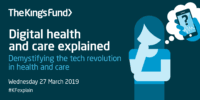 Keeping calm and carrying on (but taking precautions, staying inside, and keyboarding with hands that resemble gator hide), yes, there IS some news that isn’t entirely about COVID-19:
Keeping calm and carrying on (but taking precautions, staying inside, and keyboarding with hands that resemble gator hide), yes, there IS some news that isn’t entirely about COVID-19:
This Editor had put aside the $70 million funding by the UK’s Cera at end of February. What is interesting is that Cera Care is a hybrid–specializing in both supplying home-based care, including dementia care, and providing tech-enabled services for older adults. The funding announcement was timed with the intro of SmartCare, a sensor-based analytics platform that uses machine learning and data analytics on recorded behaviors to personalize care and detect health risks with a reported 93 percent accuracy. It then can advise carers and family members about a plan of action. This sounds all so familiar as Living Independently’s QuietCare also did much the same–in 2006, but without the smartphone app and in the Ur-era of machine learning (what we called algorithms back then).
The major raise supports a few major opportunities: 50 public sector contracts with local authorities and NHS, the rollout of SmartCare, its operations in England and Wales, and some home healthcare acquisitions. Leading the round was KairosHQ, a US-based startup builder, along with investors Yabeo, Guinness Asset Management, and a New York family office. Could a US acquisition be up next? Mobihealthnews, TechEU
Located on NYC’s Great Blank Way (a/k/a Broadway), Rx.Health has developed what they call digital navigation programs in a SaaS platform that connect various programs and feed information into EHRs. The interestingly named RxStitch engine uses text messages (Next Gen Reminder and Activation Program) or patient portals to support episodes of care (EOC), surgeries, transitions of care (TOC), increasing access to care, telehealth, and closure of care gaps. Their most recent partnership is with Valley Health in northern NJ. Of course they’ve pitched this for COVID-19 as the COVereD initiative that supports education, triage, telehealth, and home-based surveillance as part of the workflow. Rx.Health’s execs include quite a few active for years in the NY digital health scene, including Ashish Atreja, MD.
Teledentistry to the rescue! Last summer, we focused on what this Editor thought was the first real effort to use telemedicine in dentistry, The TeleDentists can support dentists who are largely closing shop for health reasons to communicate with their own patients for follow up visits, screen new patients, e-prescribe, and refer those who are feeling sick to other telehealth providers. For the next six weeks, patients pay only $49 a visit. More information in their release. Hat tip to Howard Reis.
What actions are smaller telehealth companies taking now? Reader and commenter Adrian Scaife writes from Alcuris about how their assistive technology responds to the need to keep in touch with older people living alone at home. Last week their preparations started with giving their customers the option to switch to audio/video conferencing with their market teams. This week, they reviewed how their assistive technology and ADL monitoring can keep older people safe in their homes where they may have to be alone, especially after discharge, yet families and caregivers can keep tabs on them based on activity data. A smart way for a small company to respond to the biggest healthcare challenge of the last 30 years. Release.
Even Caravan Health, a management services company for groups of physicians or health systems organizing as accountable care organizations (ACOs) in value-based care programs, is getting into digital health with their purchase of Wellpepper. The eight-year-old company based in Seattle works with health plans to provide members with outpatient digital treatment plans, messaging services, and an alert system to boost communication between care teams and patients. Purchase price was not disclosed, but Wellpepper had raised only $1.2 million in debt financing back in 2016 so one assumes they largely bootstrapped. Mobihealthnews
And if you’re stuck at home and are trying to avoid chores, you can read all 140 pages of Teladoc’s Investor Day presentation, courtesy of Seeking Alpha.















Most Recent Comments